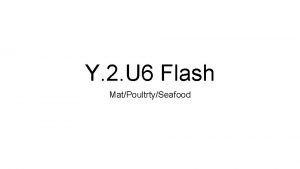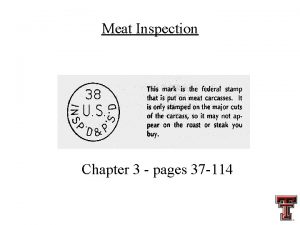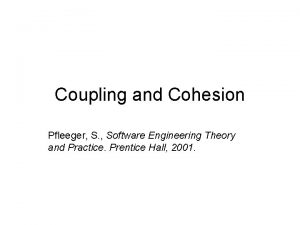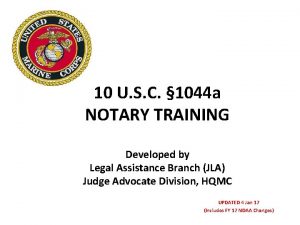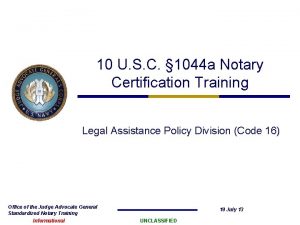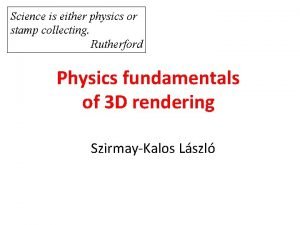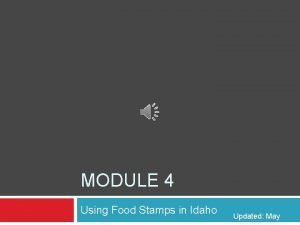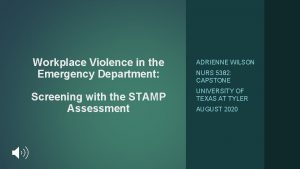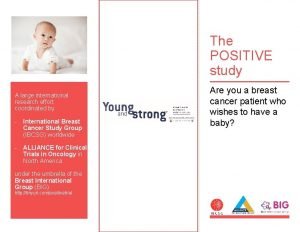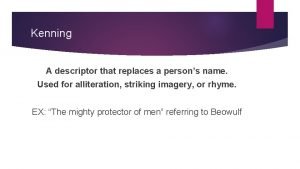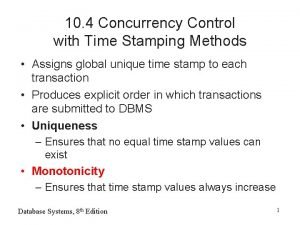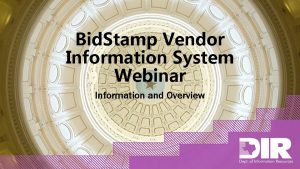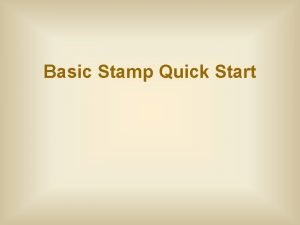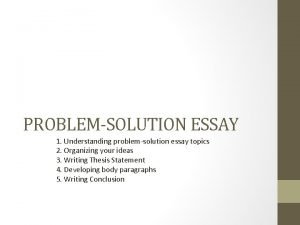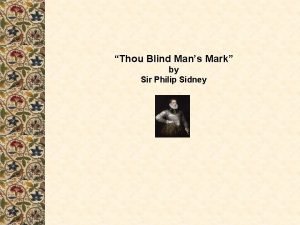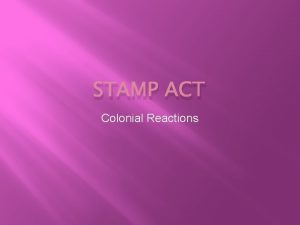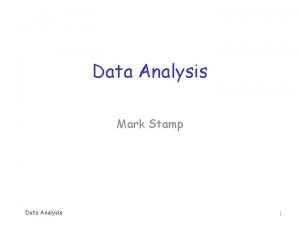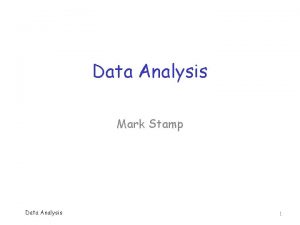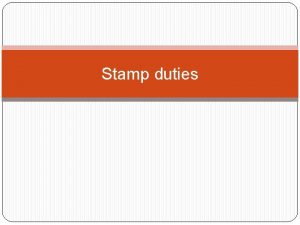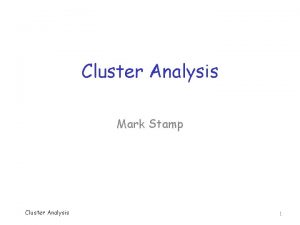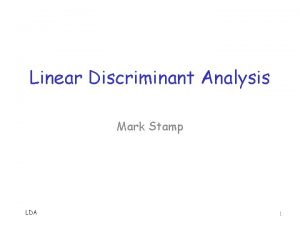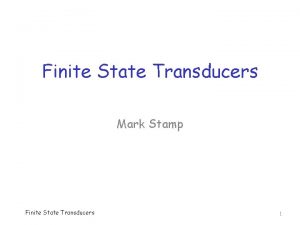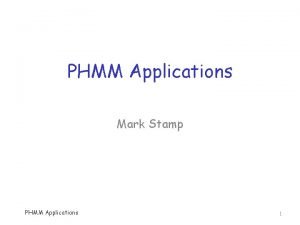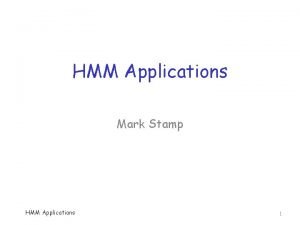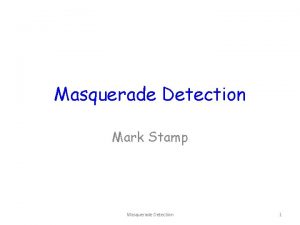Data Analysis Mark Stamp Data Analysis 1 Topics














































- Slides: 46

Data Analysis Mark Stamp Data Analysis 1

Topics q Experimental design o Training set, test set, n-fold cross validation, thresholding, imbalance, etc. q Accuracy o False positive, false negative, etc. q ROC curves o Area under the ROC curve (AUC) o Partial AUC (sometimes written as AUCp) Data Analysis 2

Objective q Assume that we have a proposed method for detecting malware q We want to determine how well it performs on specific dataset o We want to quantify effectiveness q Ideally, compare to previous work o But, often difficult to directly compare q Comparisons Data Analysis to AV products? 3

Basic Assumptions q We have a set of known malware o All from a single (metamorphic) “family”… o …or, at least all of a similar type o Broader “families” are more difficult q Also, a representative non-family set o Often, assumed to be benign files o More diverse may be more difficult q Much Data Analysis depends on problem specifics 4

Experimental Design q Want to test malware detection score o Refer to malware dataset as match set o And benign dataset is nomatch set q Partition match set into… o Training set used to determine parameters of the scoring function o Test set reserved to test scoring function generated from training set q Note: Data Analysis Cannot test on training set 5

Training and Scoring q Two phases: Training and scoring q Training phase o Train a model using training set q Scoring phase o Score data in test set and score nomatch (benign) set q Analyze results from scoring phase o Assume representative of general case Data Analysis 6

Scatterplots q Train a model on the training set q Apply score to test and nomatch sets o Can visualize results as scatterplot score match scores nomatch scores Data Analysis test case 7

Experimental Design q. A couple of potential problems… o How to partition match set? o How to get most out of limited data set? q Why are these things concerns? o When we partition match set, might get biased training/test sets, and … o … more data points is “more better” q Cross Data Analysis validation solves these problems 8

n-fold Cross Validation q Partition match set into n equal subsets o Denote subsets as S 1, S 2, …, Sn q Let training set be S 2 S 3 … Sn o And test set is S 1 q Repeat with training set S 1 S 3 … Sn o And test set S 2 q And so on, for each of n “folds” o In our work, n = 5 is usually sufficient Data Analysis 9

n-fold Cross Validation q Benefits of cross validation? q Any bias in match data smoothed out o Since bias only affects one/few of the Si q Obtain lots more match scores o Usually, no shortage of nomatch data o But match data may be very limited q And it’s easy to do, so why not? o Best of all, it sounds really fancy… Data Analysis 10

Thresholding q Set threshold after scoring phase q Ideally, we have complete separation o I. e. , no overlap in scatterplot o Usually, that doesn’t happen o So, where to set the threshold? q In practical use, thresholding critical o At research stage, more of a distraction… o …as we discuss later Data Analysis 11

Thresholding q Where to set threshold? score o Left graph is easier than right graph… test case Data Analysis test case 12

Quantifying Success q We need a way to quantify “better” score o Ideas? test case Data Analysis test case 13

Accuracy q Given scatterplot and a threshold… q We have following 4 cases o o True positive correct classified as + False positive incorrect classified as + True negative correct classified as − False negative incorrect classified as − q TP, FP, TN, FN, respectively, for short o Append “R” to each for “rate” Data Analysis 14

Accuracy q Assuming that high scores (i. e. , above threshold) match the model Data Analysis 15

Sensitivity and Specificity q The TPR also known as sensitivity while TNR is known as specificity q Consider a medical test o Sensitivity is percentage of sick people detected by the test (as they should be) o Specificity is percentage of healthy people classified as such (as they should) q Inherent tradeoff between TPR/TNR o Everything depends on threshold! Data Analysis 16

Accuracy q Let P be number of positive cases tested and N negative cases tested o Note: P is size of test set, N nomatch set o Also, P = TP + FN and N = TN + FP q Then, Accuracy = (TP + TN) / (P + N) o Note that accuracy ranges from 0 to 1 o Accuracy of 1 is the ideal case o Accuracy 0. 5? Don’t give up your day job… Data Analysis 17

Balanced Accuracy q Often, there is a large imbalance between test set and nomatch set o Test set is small relative to nomatch set q Define Balanced accuracy = (TPR + TNR) / 2 = 0. 5 TP/P + 0. 5 TN/N o Errors on both sets weighted same q Consider Data Analysis imbalance issue again later 18

Accuracy q Accuracy tells us something… o But it depends on where threshold is set o How should we set the threshold? o Seems we are going around in circles like a dog chasing its tail q Bottom line? We still don’t have good way to compare different techniques o Next slide, please… Data Analysis 19

ROC Curves q Receiver Operating Characteristic o Originated from electrical engineering o But now widely used in many fields q What is an ROC curve? o Plot TPR vs FPR by varying threshold thru the range of scores o That is, FPR on x-axis, TPR on y-axis o Equivalently, 1 – specificity vs sensitivity o What the … ? Data Analysis 20

1 TPR ROC Curve q Suppose threshold is set at yellow line o Above yellow, classified as positive, o Below yellow is negative this case, o TPR = 1. 0 o FPR = 1. 0 – TNR = 1. 0 – 0. 0 = 1. 0 Data Analysis 1 FPR score q In 0 test case 21

1 TPR ROC Curve q Suppose threshold set at yellow line o Above yellow, classified as positive, o Below yellow is negative this case, o TPR = 1. 0 o FPR = 1. 0 – TNR = 1. 0 – 0. 2 = 0. 8 Data Analysis 1 FPR score q In 0 test case 22

1 TPR ROC Curve q Suppose threshold set at yellow line o Above yellow, classified as positive, o Below yellow is negative this case, o TPR = 1. 0 o FPR = 1. 0 – TNR = 1. 0 – 0. 4 = 0. 6 Data Analysis 1 FPR score q In 0 test case 23

1 TPR ROC Curve q Suppose threshold set at yellow line o Above yellow, classified as positive, o Below yellow is negative this case, o TPR = 1. 0 o FPR = 1. 0 – TNR = 1. 0 – 0. 6 = 0. 4 Data Analysis 1 FPR score q In 0 test case 24

1 TPR ROC Curve q Suppose threshold set at yellow line o Above yellow, classified as positive, o Below yellow is negative this case, o TPR = 0. 8 o FPR = 1. 0 – TNR = 1. 0 – 0. 6 = 0. 4 Data Analysis 1 FPR score q In 0 test case 25

1 TPR ROC Curve q Suppose threshold set at yellow line o Above yellow, classified as positive, o Below yellow is negative this case, o TPR = 0. 6 o FPR = 1. 0 – TNR = 1. 0 – 0. 6 = 0. 4 Data Analysis 1 FPR score q In 0 test case 26

1 TPR ROC Curve q Suppose threshold set at yellow line o Above yellow, classified as positive, o Below yellow is negative this case, o TPR = 0. 6 o FPR = 1. 0 – TNR = 1. 0 – 0. 6 = 0. 2 Data Analysis 1 FPR score q In 0 test case 27

1 TPR ROC Curve q Suppose threshold set at yellow line o Above yellow, classified as positive, o Below yellow is negative this case, o TPR = 0. 4 o FPR = 1. 0 – TNR = 1. 0 – 0. 6 = 0. 2 Data Analysis 1 FPR score q In 0 test case 28

1 TPR ROC Curve q Suppose threshold set at yellow line o Above yellow, classified as positive, o Below yellow is negative this case, o TPR = 0. 4 o FPR = 1. 0 – TNR = 1. 0 – 0. 6 = 0. 0 Data Analysis 1 FPR score q In 0 test case 29

1 TPR ROC Curve q Suppose threshold set at yellow line o Above yellow, classified as positive, o Below yellow is negative this case, o TPR = 0. 2 o FPR = 1. 0 – TNR = 1. 0 – 0. 6 = 0. 0 Data Analysis 1 FPR score q In 0 test case 30

1 TPR ROC Curve q Suppose threshold set at yellow line o Above yellow, classified as positive, o Below yellow is negative this case, o TPR = 0. 0 o FPR = 1. 0 – TNR = 1. 0 – 0. 6 = 0. 0 Data Analysis 1 FPR score q In 0 test case 31

ROC Curve q Connect o Captures info wrt all possible thresholds o Removes threshold as a factor in the analysis q What Data Analysis does it all mean? 1 TPR the dots… q This is ROC curve q What good is it? 0 1 FPR 32

ROC Curve classifier? o Yellow 45 degree line q Perfect classifier? o Red (Why? ) q Above 45 degree line? o Better than random o The closer to the red, the closer to ideal Data Analysis 1 TPR q Random 0 1 FPR 33

Area Under the Curve (AUC) q ROC o AUC ≈ 0. 5 q Perfect classifier (red)? 1 TPR curve lives within a 1 x 1 square q Random classifier? o AUC = 1. 0 q Example curve (blue)? o AUC = 0. 8 Data Analysis 0 1 FPR 34

Area Under the Curve (AUC) q Area o 0. 5 flip a coin o 1. 0 ideal detection q AUC of ROC curve o Enables us to compare different techniques o And no need to worry about threshold, but… Data Analysis 1 TPR under ROC curve quantifies success 0 1 FPR 35

Partial AUC q Might o Area up to FPR of p o Normalized by p q In 1 TPR only consider cases where FPR < p q “Partial” AUC is AUCp this example, AUC 0. 4 = 0. 2 / 0. 4 = 0. 5 AUC 0. 2 = 0. 08/0. 2 = 0. 4 Data Analysis 0 1 FPR 36

Imbalance Problem q Suppose we train model for given malware family q In practice, we expect to score many more non-family files than family o Number of negative cases is large o Number of positive cases is small q So what? q Let’s consider an example Data Analysis 37

Imbalance Problem q In practice, we need threshold q For a given threshold, suppose sensitivity = 0. 99, specificity = 0. 98 o Then TPR = 0. 99 and FPR = 0. 02 q Assume 1 in 1 k files tested is malware o Of the type our model trained to detect q Suppose we scan, say, 100 k files o What do we find? Data Analysis 38

Imbalance Problem q Assuming TPR = 0. 99 and FPR = 0. 02 o And 1 in 1000 is malware q After scanning 100 k files… o Detect 99 of 100 actual malware (TP) o Misclassify 1 malware as benign (FN) o Correctly classify 97902 (out of 99900) benign as benign (TN) o Misclassify 1998 benign as malware (FP) Data Analysis 39

Imbalance Problem q We have 97903 classified as benign o Of those, 97902 are actually benign o And 97902/97903 > 0. 9999 q We classified 2097 as malware o Of these, only 99 are actual malware o But 99/2097 < 0. 05 q Remember the “boy who cried wolf”? o Here, the detector cries wolf (a lot)… Data Analysis 40

Imbalance Solution? q What to do? q There is inherent tradeoff between sensitivity and specificity q Suppose we can adjust threshold so o TPR = 0. 92 and FPR = 0. 0003 q As before… o We have 1 in 1000 is malware o And we test 100 k files Data Analysis 41

Imbalance Solution? q Assuming TPR = 0. 92 and FPR = 0. 0003 o And 1 in 1000 is malware q After scanning 100 k files… o Detect 92 of 100 actual malware (TP) o Misclassify 8 malware as benign (FN) o Correctly classify 99870 (out of 99900) benign as benign (TN) o Misclassify 30 benign as malware (FP) Data Analysis 42

Imbalance Solution? q We have 99878 classified as benign o Of those, all but 8 are actually benign o And 99870/99878 > 0. 9999 q We classified 122 as malware o Of these, 92 are actual malware o And 92/122 > 0. 75 q Can adjust threshold to further reduce “crying wolf” effect Data Analysis 43

Imbalance Problem q. A better alternative? q Instead of increasing FPR to lower TPR o Perform secondary testing on files that are initially classified as malware o We can thus weed out most FP cases q This gives us best of both worlds o Low FPR, few benign reported as malware q No free lunch, so what’s the cost? Data Analysis 44

Bottom Line q Design your experiments properly o Use n-fold cross validation (e. g. , n = 5) o Generally, cross validation is important q Thresholding is important in practice o But not so useful for analyzing results o Accuracy not as informative as ROC analysis q Use ROC curves and compute AUC o Sometimes, partial AUC may be better q Imbalance problem may be significant issue Data Analysis 45

References q A. P. Bradley, The use of the area under the ROC curve in the evaluation of machine learning algorithms, Pattern Recognition, 30: 1145 -1159, 1997 Data Analysis 46
 Shellstock identification tags
Shellstock identification tags Ca stamp format
Ca stamp format Place stamp here
Place stamp here Pan african movement stamp
Pan african movement stamp Stamp duty(amendment) proclamation no. 612/2008
Stamp duty(amendment) proclamation no. 612/2008 Migratory bird hunting and conservation stamp act
Migratory bird hunting and conservation stamp act On package
On package Define coupling in software engineering
Define coupling in software engineering 10 usc 1044a notary stamp
10 usc 1044a notary stamp 10 usc 1044a
10 usc 1044a Sugar and stamp act
Sugar and stamp act App.avantassessment.com/test
App.avantassessment.com/test Rutherford stamp collecting
Rutherford stamp collecting Inward mail register
Inward mail register Clone stamp tool photoshop definition
Clone stamp tool photoshop definition Idaho food stamp balance
Idaho food stamp balance Sugar and stamp act
Sugar and stamp act Stamp workplace violence
Stamp workplace violence The stamp tax uproar
The stamp tax uproar Miss lawrence billie holiday
Miss lawrence billie holiday Place stamp here
Place stamp here Place stamp here
Place stamp here Rug rat kenning
Rug rat kenning Nanny shine has got
Nanny shine has got Basic stamp programming
Basic stamp programming Is the mark of the beast figurative or literal
Is the mark of the beast figurative or literal Cdc stamp
Cdc stamp 4 cent house
4 cent house Rubber dam
Rubber dam A heap of stones collective noun
A heap of stones collective noun Time stamping in database
Time stamping in database Boston tea party stamp
Boston tea party stamp Sophie scholl thilde scholl
Sophie scholl thilde scholl Postage stamp technique extraction
Postage stamp technique extraction Joe louis postage stamp
Joe louis postage stamp Why did the colonists resent the stamp act?
Why did the colonists resent the stamp act? Bidstamp
Bidstamp Basic stamp ii
Basic stamp ii Stamp
Stamp Thesis statement in problem solution essay
Thesis statement in problem solution essay Advanced topics in software analysis and testing
Advanced topics in software analysis and testing Simple content analysis
Simple content analysis Discourse analysis topics
Discourse analysis topics Data warehouse research topics
Data warehouse research topics Bin yao
Bin yao The blind man's mark
The blind man's mark The mark edyth bulbring characters
The mark edyth bulbring characters
